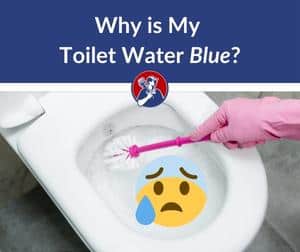
Did you flush your toilet only to notice blue water enter your toilet bowl? While unnerving at first, blue water in residential toilets occurs fairly often.
Naturally, you want to know what caused the blue water and how to get your regular clear toilet water back. We’ve got you! We will answer all your questions in detail.
In this PlumbingNav guide, we cover:
- Why is my toilet water blue?
- The truth about blue toilet water
- How to get rid of blue toilet water: best methods
- Supplies you’ll need for blue stains on the toilet bowl
| What's In This Guide? | |
|---|---|
|
|
|
Why Is My Toilet Water Blue?
If you’ve ever opened up your toilet seat to find a pool of blue water, you may be wondering why is my toilet water blue?
In most cases, the blue color is due to a change in the way the water is treated. Some municipalities add extra chlorine to the water supply during hot weather or when there is a risk of contamination.
This can cause the water to turn blue when it mixes with the chemicals in your toilet bowl. If you suspect high chlorine levels, be careful not to clean your toilet with products that contain ammonia, as chlorine and ammonia create toxic fumes when combined.
In other cases, the blue color may be due to a dye that is used to track the flow of water through the pipes. If you notice a blue stain in your toilet bowl, it is probably because the dye has built up over time and has become more concentrated.
While a sign that the city is keeping tabs on the water supply, you probably don’t appreciate the blue stains. If you are concerned about the color of your toilet water, you can contact your local water utility for more information so you can pinpoint the cause.
What Makes Toilet Water Blue?
Keep in mind that some buildings, especially commercial buildings, use blue cleaners to prove that the toilets were actually cleaned. You may be the first person using the facilities since they’ve been cleaned, which is why you see the blue water.
A blue stain in your toilet bowl may also be the result of cleaning products, such as blue toilet tablets.
Blue toilet tablets clean your toilet after every flush. The blue coloring comes from the chemicals in the cleaning product. The chemicals can stain your toilet bowl, especially if you use the tablets more often than recommended.
If you see blue water at home and you know you haven’t recently cleaned the toilets, the cause probably lies with your water supply.
Cause Of Blue Ring In Toilet Bowl
If you’ve ever noticed a blue ring in your toilet bowl, you may be wondering what caused it. There are actually a few different reasons why this may happen.
One possibility is that your home has copper pipes. When water passes through copper pipes, it can pick up small amounts of copper. This can then be deposited in the toilet bowl, causing a blue stain.
Another possibility is that you have a high concentration of iron in your water. Iron is often used as a rust inhibitor in plumbing systems. However, too much iron can cause staining and discoloration. If you’re concerned about the cause of your blue toilet bowl, it’s best to contact a plumber or water treatment specialist for further advice.
Finally, a blue ring in the toilet bowl can indicate corrosion. Corrosion affects all metal pipes over time. The rust created by corrosion can create a blue ring.
What Causes Blue Stain In Toilet Bowl
Water stains can appear blue in your toilet, especially when your water contains high levels of oxygen.
These tough stains can be difficult to tend to, so start as soon as you see them using your toilet brush, vinegar and baking soda, and, finally, mild sandpaper.
Why is My Toilet Water Blue? Top Two Reasons Explained
#1: Blue Toilet Tablets
Sometimes, blue toilet water is from a product you’re using. Homeowners love the convenience of blue toilet tablets, such as the popular product 2000 Flushes. You put the bleach tablet in the toilet tank and let the tablet work its magic as you use the toilet like normal. It not only kills pink mold, but gives you that “oh so clean” visual pat-on-the-back.
Most toilet tablets use a blue dye to purposefully turn the water blue as they clean. The blue water not only makes the toilet look clean and fresh but also reassures the homeowner that the product works.
While convenient and surface-level effective, blue toilet tablets may eventually eat at the seals around your toilet or the toilet parts and plumbing itself, such as the flush valve. This is especially true if you use a toilet tablet more often than recommended, exposing your pipes to excessive chlorine levels.
Toilet leaks generally start small, almost unnoticeable, and build up veracity and speed with time like a snowball. Learn how to detect toilet leaks early to manage and minimize damage before it snowballs into something very inconvenient (and expensive).
Stains from the blue dye in toilet tablets tend to develop unevenly and result in a vibrant, unnatural hue. If this is the culprit beyond your constantly blue toilet water level, change products.
#2: Copper Piping Corrosion
Extremely popular in the construction of houses built in the 1900s, copper pipes still show up fairly often in both old and new plumbing construction.
Once considered a high-end option for pipes transporting nonpotable water, plumbers have noticed some disadvantages of using copper pipes compared to newer synthetic plumbing materials, such as PEX.
Copper pipes can last up to 50 years since the strong metal material withstands high water pressure and hot water, hindering the corrosion process (but not stopping it completely).
Copper pipes quickly surpassed lead pipes in popularity since lead pipes deteriorate from corrosion much more quickly. If you’re interested, you can read more about the metal pipe wars.
However, new materials may eventually make copper pipes a thing of the past (similar to what copper did to lead). Copper costs significantly more than PEX and also costs more to install thanks to its limited flexibility.
And since PEX does not contain metal, it will never lead to rust and corrosion.
While it may take years, copper, on the other hand, eventually corrodes, increasing toxin levels in your home’s water and causing the blue water you see in your toilet.
Copper corrodes when exposed to high levels of oxygen and chlorine, changing the composition of the material. Heat, pressure and standing water may expedite the corrosion process.
What do corrosion stains look like?
If you notice an even blue ring in your toilet, it probably developed as a result of copper corrosion. The increased oxygen levels in the copper pipes cause water to turn blue and leave rustic blue stains, more rustic and muted than the bright hue of blue dye.
You will know high copper levels are to blame if you notice blue stuff in various toilets throughout your house, especially if your neighbors experience similar issues.
If you see orange-tinted, rusty stains, you may blame corrosion at first. However, the dark color indicates hard water stains resulting from your water supply providing your home with hard water (water with exceptionally high mineral content).
These elements can also combine to form a brown stain on the toilet bowl itself.
The Truth About Blue Toilet Water?
Some people appreciate blue toilet water for its aesthetic appeal and this is why products that produce it are popular. However, the blue water screams one thing rather loudly: the toilet contains high levels of foreign materials, such as minerals and chemicals.
To be clear, the blue dye contains no actual cleaning properties itself (most tablets use chlorine as the active ingredient). Consumers seem to like the blue dye, though, until the blue color doesn’t go away as expected.
The problem isn’t so much the dye as the chemicals in the tablet.
The truth about blue toilet water caused by corrosion has the potential to be even more alarming, depending on the extent of the damage of your actual plumbing pipes when repairs are needed.
How To Get Rid of Blue Toilet Water: Best #2 Methods
Clean Toilet (Without Blue Tablets)
Toxic colors in the wild indicate poison, and you can apply this same theory to blue toilet water caused by blue tablets.
The unnatural fluorescent blue color tells you that too many chemicals from the tablet remain in your toilet instead of properly flushing down the drain and away from your house.
Remove the blue water by cleaning the inside of your toilet bowl using a mixture of white vinegar and baking soda or a gentle toilet bowl cleaner and a toilet brush. After you clean the bowl, check the toilet seat for blue stains, too.
Once you remove the stain, flush the chemicals out of your toilet thoroughly until you no longer see a blue tint in the water level.
Prevent Corrosion
Your plumbing maintenance and cleaning routine play a large role in the lifespan of your pipes, and this is a situation in which the best offense consists of a great defense.
Some ways to prevent corrosion of copper pipes include:
- Lower the water temperature
- Lower the water pressure
- Adjust water pH levels
- Regularly clean mildew and corrosion off of the pipes and the surrounding area
- Insulate your pipes
- Resolve clogs and leaks immediately
- Limit the use of chemicals in cleaning and maintenance
If the pipe deterioration reaches a certain point, you will need to enlist professional plumbing services to replace your pipes altogether.
The blue stains that develop from corrosion may require some additional elbow grease, but you will treat them in a similar fashion. Here are some tips in the below video.
Supplies You’ll Need for Blue Stains on Toilet Bowl
Toilet Cleaner
You will need proper cleaning supplies to treat blue stains in your toilet, including a quality toilet cleaning product (preferably not powered by chlorine / Clorox bleach). Many all-purpose bathroom cleaners will do the trick, and you can also use a mixture of vinegar and baking soda.
Do not use a blue tablet (however, you can try a natural pumice stone instead).
Toilet Brush
You will need a toilet brush that allows you to reach into your toilet bowl without getting your hands dirty and clean the surface with the brush bristles.
Look for models that come with a designated holster and self-cleaning properties.
Properly clean and dry your toilet brush after each use to prevent bristles from turning hard and harboring germs.
Final Thoughts On Getting Rid of Blue Toilet Water
Tap water enters your home clear. (At least it should!)
If you notice blue water or a blue stain, you probably have excessive levels of chemicals or copper affecting your water supply.
While not a reason to call an emergency plumber, you want to address the situation immediately by taking action to reduce the corrosion process and using gentle cleansers.
When all else fails, consider the advantage of modern PEX piping or long-lasting PVC for your next upgrade.
Get Fast, Local Plumbing Service
Connect with an expert plumber in your local area to tackle any job – big or small. Find help with leaks, clogs, or full installations.
Select your service category on the form, provide your details, and an expert plumber will be in touch!
Plumbing Navigator is an informational site that connects visitors with local plumbers but does not directly provide plumbing services or operate as a licensed company.
FAQs on Blue Toilet Water
What makes water blue in the toilet?
You may experience blue toilet bowl water if you regularly use a cleaning tablet with blue dye or if you have copper pipes starting to corrode.
How do I get blue water out of my toilet?
Take action quickly to prevent permanent stains. Use a gentle cleanser, gradually increasing chemical content as milder products don’t work. Thoroughly flush all chemicals away from your house.
Is blue toilet water safe?
While not typically fatal, no, blue toilet water isn’t necessarily safe.
Related: Need to adjust toilet water levels? See this post if your toilet tank is not filling or keeps running.
Meet Your Plumbing Navigator

About Plumbing Navigator
We’re passionate about all things plumbing, and love sharing tips, “how-to”, and reviewing the latest products to help make your project a success!
Learn More Plumbing Tips
Want to tackle more plumbing projects? Check out these helpful guides!






